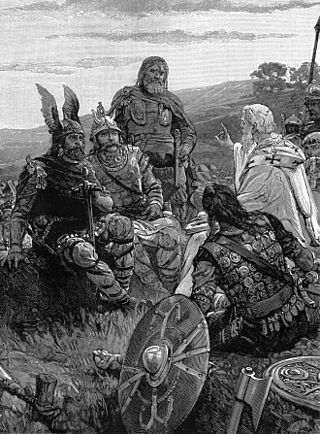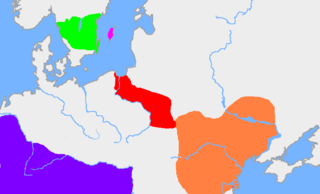
The Goths were Germanic people who played a major role in the fall of the Western Roman Empire and the emergence of medieval Europe.

Valens was Roman emperor from 364 to 378. Following a largely unremarkable military career, he was named co-emperor by his elder brother Valentinian I, who gave him the eastern half of the Roman Empire to rule. In 378, Valens was defeated and killed at the Battle of Adrianople against the invading Goths, which astonished contemporaries and marked the beginning of barbarian encroachment into Roman territory.
The 380s decade ran from January 1, 380, to December 31, 389.
The 370s decade ran from January 1, 370, to December 31, 379.
Year 380 (CCCLXXX) was a leap year starting on Wednesday of the Julian calendar. At the time, it was known as the Year of the Consulship of Augustus and Augustus. The denomination 380 for this year has been used since the early medieval period, when the Anno Domini calendar era became the prevalent method in Europe for naming years.

Year 369 (CCCLXIX) was a common year starting on Thursday of the Julian calendar. At the time, it was known as the Year of the Consulship of Galates and Victor. The denomination 369 for this year has been used since the early medieval period, when the Anno Domini calendar era became the prevalent method in Europe for naming years.
Fritigern was a Thervingian Gothic chieftain whose decisive victory at Adrianople during the Gothic War (376–382) led to favourable terms for the Goths when peace was made with Gratian and Theodosius I in 382.

The Battle of Adrianople, sometimes known as the Battle of Hadrianopolis, was fought between an Eastern Roman army led by the Eastern Roman Emperor Valens and Gothic rebels led by Fritigern. The battle took place in the vicinity of Adrianople, in the Roman province of Thracia. It ended with an overwhelming victory for the Goths and the death of Emperor Valens.

Valentinian I, sometimes called Valentinian the Great, was Roman emperor from 364 to 375. He ruled the Western half of the empire, while his brother Valens ruled the East. During his reign, he fought successfully against the Alamanni, Quadi, and Sarmatians, strengthening the border fortifications and conducting campaigns across the Rhine and Danube. His general Theodosius defeated a revolt in Africa and the Great Conspiracy, a coordinated assault on Roman Britain by Picts, Scoti, and Saxons. Valentinian founded the Valentinianic dynasty, with his sons Gratian and Valentinian II succeeding him in the western half of the empire.
Alatheus and Saphrax were Greuthungi chieftains who served as co-regents for Vithericus, son and heir of the Gothic king Vithimiris.

Between 376 and 382 the Gothic War against the Eastern Roman Empire, and in particular the Battle of Adrianople, is commonly seen as a major turning point in the history of the Roman Empire, the first of a series of events over the next century that would see the collapse of the Western Roman Empire, although its ultimate importance to the Empire's eventual fall is still debated. It was one of the many Gothic Wars with the Roman Empire.
Domnica was the wife of Roman emperor Valens. Valens, who ruled from 364 to 378, was emperor of the East and co-emperor with his brother Valentinian I. After the death of her husband in 378 she ruled as de facto regent and defended Constantinople against the attacking Goths until his successor, Theodosius I arrived.
The Thervingi, Tervingi, or Teruingi were a Gothic people of the plains north of the Lower Danube and west of the Dniester River in the 3rd and the 4th centuries.
The Goths, Gepids, Vandals, and Burgundians were East Germanic groups who appear in Roman records in late antiquity. At times these groups warred against or allied with the Roman Empire, the Huns, and various Germanic tribes.

The Greuthungi were a Gothic people who lived on the Pontic steppe between the Dniester and Don rivers in what is now Ukraine, in the 3rd and the 4th centuries. They had close contacts with the Tervingi, another Gothic people, who lived west of the Dniester River. To the east of the Greuthungi, living near the Don river, were the Alans.

The Taifals or Tayfals were a people group of Germanic or Sarmatian origin, first documented north of the lower Danube in the mid third century AD. They experienced an unsettled and fragmented history, for the most part in association with various Gothic peoples, and alternately fighting against or for the Romans. In the late fourth century some Taifali were settled within the Roman Empire, notably in western Gaul in the modern province of Poitou. They subsequently supplied mounted units to the Roman army and continued to be a significant source of cavalry for early Merovingian armies. By the sixth century their region of western Gaul had acquired a distinct identity as Thifalia.
Flavius Saturninus was a Roman army officer and politician.

Valentinianus Galates was the only son of the Roman emperor Valens, who ruled the Roman Empire during Late Antiquity. Born into the ruling Valentinianic dynasty, Valentinianus became Roman consul as an infant, but he died in early childhood, and the empire passed to the sons and daughter of Valentinian the Great, Valentinianus Galates's uncle.
The Battle of Marcianople or Marcianopolis took place in 376 following the Goths' migration over the Danube. It was the first notable battle of the Gothic War of 376–382.
The history of the Huns spans the time from before their first secure recorded appearance in Europe around 370 AD to after the disintegration of their empire around 469. The Huns likely entered Western Asia shortly before 370 from Central Asia: they first conquered the Goths and the Alans, pushing a number of tribes to seek refuge within the Roman Empire. In the following years, the Huns conquered most of the Germanic and Scythian tribes outside of the borders of the Roman Empire. They also launched invasions of both the Asian provinces of Rome and the Sasanian Empire in 375. Under Uldin, the first Hunnic ruler named in contemporary sources, the Huns launched a first unsuccessful large-scale raid into the Eastern Roman Empire in Europe in 408. From the 420s, the Huns were led by the brothers Octar and Ruga, who both cooperated with and threatened the Romans. Upon Ruga's death in 435, his nephews Bleda and Attila became the new rulers of the Huns, and launched a successful raid into the Eastern Roman Empire before making peace and securing an annual tribute and trading raids under the Treaty of Margus. Attila appears to have killed his brother and became sole ruler of the Huns in 445. He would go on to rule for the next eight years, launching a devastating raid on the Eastern Roman Empire in 447, followed by an invasion of Gaul in 451. Attila is traditionally held to have been defeated in Gaul at the Battle of the Catalaunian Fields, however some scholars hold the battle to have been a draw or Hunnic victory. The following year, the Huns invaded Italy and encountered no serious resistance before turning back.










